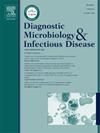Evaluation of a commercial ELISA IgG antibody Kit for Orthoflavivirus nilense (West Nile Virus): Screening utility and comparison with virus neutralization test
IF 1.8
4区 医学
Q3 INFECTIOUS DISEASES
Diagnostic microbiology and infectious disease
Pub Date : 2025-09-03
DOI:10.1016/j.diagmicrobio.2025.117098
引用次数: 0
Abstract
The diagnostic performance of a commercially available ELISA IgG antibody test for Orthoflavivirus nilense (ONV, formerly West Nile Virus) was evaluated using the virus neutralization (VN) test as the reference method. A total of 494 previously collected human serum samples were analyzed. Of the 40 ELISA IgG antibody positive samples, 38 were confirmed by VN, while VN detected 41 positive samples in total. The ELISA IgG antibody test demonstrated a sensitivity of 92.68 %, specificity of 99.56 %, positive predictive value of 95.00 %, and negative predictive value of 99.34 %, with an overall accuracy of 98.99 %. Receiver Operating Characteristic (ROC) analysis revealed a high discriminative performance (Area Under the Curve (AUC): 0.961). These results suggested that the ELISA IgG antibody test can serve as a rapid, economical, and automation-compatible screening assay for ONV antibody detection in outbreak settings and large-scale surveillance. However, due to potential cross-reactivity with antigenically related flaviviruses, all ELISA-reactive results must be confirmed by VN or plaque reduction neutralization test (PRNT) in compliance with World Organisation for Animal Health (WOAH) guidance to ensure virus-type–specific antibody identification.
西尼罗病毒(Orthoflavivirus nilense,西尼罗病毒)市售ELISA IgG抗体试剂盒的评价:筛选效用及与病毒中和试验的比较。
采用病毒中和(VN)试验作为参考方法,对市售的正黄病毒尼罗病毒(ONV,前身为西尼罗病毒)ELISA IgG抗体检测的诊断性能进行了评估。对先前收集的494份人血清样本进行了分析。40份ELISA IgG抗体阳性样本中,VN确诊38份,VN共检出41份阳性样本。ELISA IgG抗体检测灵敏度为92.68%,特异度为99.56%,阳性预测值为95.00%,阴性预测值为99.34%,总体准确率为98.99%。受试者工作特征(ROC)分析显示,该方法具有良好的判别性能(曲线下面积(AUC): 0.961)。这些结果表明,ELISA IgG抗体检测可作为一种快速、经济、自动化兼容的ONV抗体检测筛查方法,用于疫情环境和大规模监测。然而,由于与抗原性相关的黄病毒具有潜在的交叉反应性,所有elisa反应性结果必须通过VN或斑块减少中和试验(PRNT)确认,以符合世界动物卫生组织(WOAH)的指导方针,以确保病毒类型特异性抗体鉴定。
本文章由计算机程序翻译,如有差异,请以英文原文为准。
求助全文
约1分钟内获得全文
求助全文
来源期刊
CiteScore
5.30
自引率
3.40%
发文量
149
审稿时长
56 days
期刊介绍:
Diagnostic Microbiology and Infectious Disease keeps you informed of the latest developments in clinical microbiology and the diagnosis and treatment of infectious diseases. Packed with rigorously peer-reviewed articles and studies in bacteriology, immunology, immunoserology, infectious diseases, mycology, parasitology, and virology, the journal examines new procedures, unusual cases, controversial issues, and important new literature. Diagnostic Microbiology and Infectious Disease distinguished independent editorial board, consisting of experts from many medical specialties, ensures you extensive and authoritative coverage.

 求助内容:
求助内容: 应助结果提醒方式:
应助结果提醒方式:


